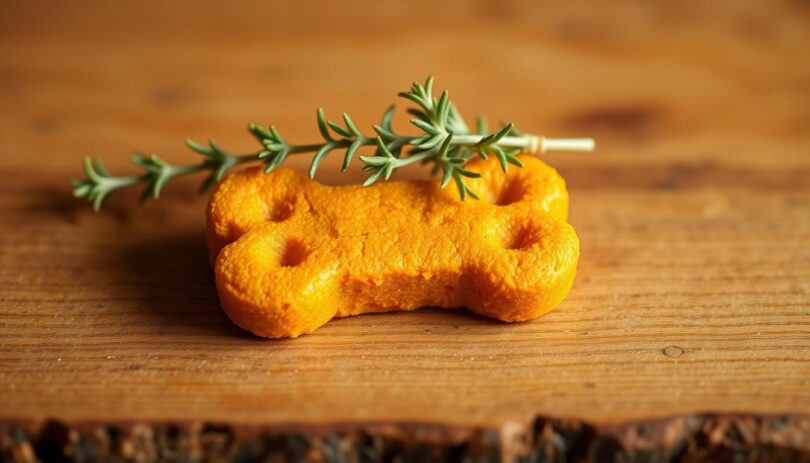What if a simple kitchen staple could transform your pet’s health? This vibrant orange ingredient isn’t just for pies—it’s packed with vitamins, minerals, and digestive benefits that might surprise even seasoned pet owners.
Rich in fiber and prebiotics, this natural powerhouse helps balance sensitive stomachs. Studies show it can ease both diarrhea and constipation in canines while delivering essential nutrients like potassium, iron, and vitamins A and C. The key lies in using plain, additive-free versions to maximize benefits.
This guide explores safe serving sizes, preparation methods, and creative ways to incorporate this nutrient-rich food into meals. Learn how to select quality products and avoid common mistakes that could undermine its advantages. From soothing upset tummies to boosting skin health, discover why this humble ingredient deserves a spot in your pet’s diet.
An Introduction to Pumpkin’s Benefits for Dogs
Have you ever wondered how a common fall ingredient can boost your furry friend’s well-being? Packed with fiber, vitamins A and C, and potassium, this vibrant orange flesh offers more than seasonal charm. Its natural nutrients work wonders for digestive balance and overall vitality, making it a vet-approved addition to meals.
The soluble fiber in canned pumpkin acts like a digestive thermostat. It absorbs excess water to firm loose stools or adds bulk to ease occasional constipation. This dual-action support helps keep bowel movements regular without harsh medications.
Always choose plain, unsweetened varieties—pie fillings often contain sugars and spices harmful to pets. The right kind provides prebiotics that nourish beneficial gut bacteria. Veterinarians frequently recommend it as a safe, natural remedy for sensitive stomachs.
From supporting skin health to enriching meals, this nutrient-dense food delivers multiple perks. Later sections will explore proper portions and creative ways to incorporate it into your pup’s diet. Stay tuned for simple recipes and expert feeding tips!
Understanding Your Dog’s Digestive Health & Pumpkin’s Impact
Why do vets frequently suggest a seasonal squash for balancing canine digestion? Tummy troubles often stem from stress, sudden food switches, or infections. While mild cases resolve quickly, persistent issues might signal parasites or chronic conditions requiring professional care.
Causes of Diarrhea and Constipation in Dogs
Loose stools can erupt from dietary indiscretions, bacterial imbalances, or anxiety. Conversely, hard stools may indicate dehydration or insufficient fiber intake. Watch for red flags like blood in waste, vomiting, or lethargy—these demand immediate veterinary attention.
How Fiber and Prebiotics Support Your Dog’s Digestion
Soluble fiber acts like a sponge, soaking up excess fluid during diarrhea while adding gentle bulk to ease constipation. This dual-action approach stabilizes bowel movements naturally. Simultaneously, prebiotics in certain foods feed beneficial gut microbes, strengthening digestive resilience.
Moderation proves crucial—overdoing fiber-rich additions can backfire. Start with teaspoon-sized portions for small breeds, gradually adjusting based on your pet’s response. Always consult your veterinarian before overhauling meals, especially for pups with existing health conditions.
Pumpkin Puree for Dogs: Feeding Guidelines and Safety
How much of this orange superfood should your companion receive? Proper portion control ensures digestive benefits without unintended consequences. Start with small quantities and adjust based on weight, monitoring reactions closely.
Determining the Right Amount for Different Dog Sizes
Tailor servings to your pet’s weight for optimal results. Extra-small breeds (under 20 lbs) thrive on 2-3 teaspoons per meal, while large dogs (51-90 lbs) may need 4-5 tablespoons. Always measure precisely using kitchen tools rather than estimating.
Choose plain canned pumpkin without additives—pie fillings often contain xylitol, a dangerous sweetener. Mix the measured amount into regular meals or freeze into cubes for summer snacks. Overfeeding can lead to loose stools, defeating the purpose of digestive support.
Consulting Your Veterinarian on Dietary Changes
Schedule a checkup before introducing new foods, especially for pets with chronic conditions. Vets assess individual needs considering age, activity level, and existing medications. They might suggest specific brands or preparation methods for maximum safety.
Watch for changes in energy levels or bathroom habits after adding this ingredient. Remember that supplements shouldn’t exceed 10% of daily calories. Pair sensible portions with fresh water access to maintain hydration balance.
Cooking and Preparing Homemade Pumpkin Puree
Crafting homemade versions ensures quality control while preserving essential nutrients. This hands-on approach lets pet owners avoid additives found in some commercial products. Follow these guidelines to create a safe, nutritious supplement for canine companions.
Step-by-Step Guide to Roasting and Blending
Begin by selecting small sugar pumpkins with firm, unblemished skin. Preheat the oven to 350°F while washing and halving the squash. Remove seeds and stringy pulp using a sturdy spoon—reserve seeds for roasting if desired.
Place halves cut-side down on a baking sheet. Roast 50-60 minutes until flesh pierces easily with a fork. Cool completely before scooping softened insides into a food processor. Blend in batches until velvety smooth.
Mastering Texture and Storage
Consistency matters—overly watery blends lack nutritional density. If needed, strain through cheesecloth or simmer gently to reduce moisture. For thick mixtures, add teaspoons of water while processing.
Portion finished puree into airtight containers. Freeze silicone molds for single-serving treats. Refrigerated batches stay fresh up to seven days. Always discard unused portions showing discoloration or odd odors.
Creative Dog Treats and Meal Enhancements
Transform ordinary snacks into nutrient-packed adventures with simple kitchen creativity. This versatile ingredient shines in homemade goodies that engage pets physically and mentally while delivering health benefits.
DIY Recipes for Tail-Wagging Delights
Whip up pupcakes by blending canned pumpkin with oat flour and eggs. Bake at 350°F for 20 minutes, then top with a yogurt drizzle. For crunchy biscuits, mix puree with coconut flour and parsley—roll dough thin before cutting shapes.
Freeze blended pumpkin and unsweetened applesauce in silicone molds for cooling summer bites. Layer with peanut butter in lick mats to slow down eager eaters. Always use plain varieties without added sugars or spices.
Interactive Play Meets Nutritional Boosts
Stuff rubber toys with frozen puree to create engaging puzzles. Hide small portions inside cardboard tubes wrapped in towels for scent-based challenges. These activities satisfy natural foraging instincts while providing fiber.
Portion treats based on your companion’s size—a teaspoon per 10 pounds of body weight prevents overindulgence. Rotate recipes weekly to discover which combinations spark the most enthusiasm. Always supervise new snack introductions.
Wrap-Up: Enhancing Your Dog’s Diet with Natural Ingredients
Natural ingredients can revolutionize your pet’s nutrition in surprising ways. The vibrant orange superfood supports digestive health, delivers essential vitamins, and adds excitement to meals. Its soluble fiber stabilizes bowel movements, while antioxidants boost overall wellness. Always select plain varieties without additives—pie fillings often hide harmful sugars.
Moderation remains critical. Start with small portions based on weight, and consult a veterinarian before dietary changes. Overdoing it can cause stomach upset or nutrient imbalances. Pair sensible servings with complete meals to maintain nutritional harmony.
Get creative with this versatile ingredient. Freeze blended mixtures into cooling snacks or bake them into crunchy biscuits. Use silicone molds for portion-controlled treats that engage curious pups. Remember to store homemade batches in airtight containers for freshness.
When used thoughtfully, simple additions can elevate everyday feeding routines. Experiment with recipes that prioritize safety and balance. Your furry companion’s tail wags might just become your new kitchen soundtrack.
FAQ
What are the main benefits of adding pumpkin to a dog’s diet?
Pumpkin provides soluble fiber to regulate digestion, vitamins like A and C for immune support, and potassium for muscle function. Its low-calorie profile makes it ideal for weight management.
Can pumpkin help with both diarrhea and constipation in dogs?
Yes. The soluble fiber absorbs excess water to firm stools during diarrhea, while softening hard stools during constipation. Always consult a vet to rule out underlying issues.
How much pumpkin puree is safe to give my dog daily?
Small breeds (under 20 lbs) can have 1–2 teaspoons, while larger dogs (over 50 lbs) may tolerate 1–2 tablespoons. Introduce gradually and monitor for digestive changes.
Is canned pumpkin safe for dogs?
Plain canned pumpkin (not pie filling) is safe if it contains no additives. Check labels for sugars, spices, or preservatives, which can harm pets.










Leave a Comment